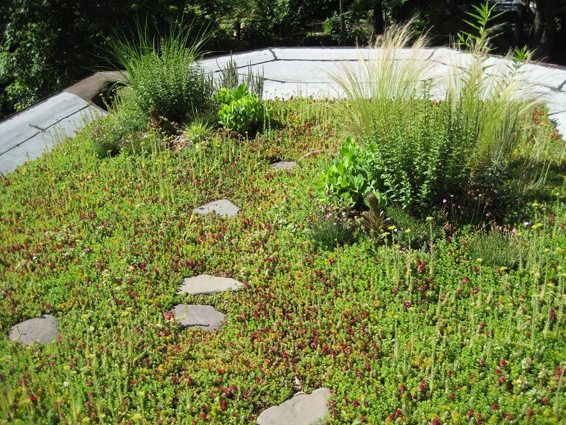
Perfecting urban green roofs for their environmental and social benefits is a good example of where science and design meet.
The benefits of green roofs include insulation, reduced energy use, the removal of air pollutants and green house gases, increased roof lifespan, reduced heat stress, stormwater runoff management, beautification, and improved health.
There are two types of green roofs—extensive and intensive. Extensive green roofs have a soil depth of 1”- 5,” and are planted with sedums and short grasses. Intensive green roofs need at least one foot of soil and can be vegetated with trees, shrubs, and perennials.
Biology PhD candidate at York University in Toronto Scott McIvor has questioned the performance of sedum to absorb water and promote biodiversity, claiming that plants adapted to local conditions work better.
Sedum doesn’t absorb water as efficiently as some native species, while it is useful for lowering the building energy requirements of air-conditioning and heating.
Determining which green roofs plants best support biodiversity requires finding the right soil composition for microorganisms to live in. This is an ongoing question scientists are exploring.
Figuring out how to best integrate sedum with other plants, to maximize the potential benefits of a green roof, is where design comes in. Producing a green roof for rainwater run-off and climate management requires creative and efficient design.
Alive Structures is a company of landscape designers and environmentalists based out of Brooklyn. They do residential, community, and educational green roof and garden projects across the five boroughs. Their green roofs often integrate locally grown sedum mats with native plants.
Part of what makes a particular landscape architecture piece interact well with its environment is its artistic quality—a design for beauty as well as function.
I learned this from a friend and gardener, who taught me that working with plants is an art, as much as working with musical notes, letters, or pictures.
The shape and placement of plants produces a wide array of feelings in us, and can contribute dynamically to how we interpret the city’s architecture.
Of course, as a green roof is a part of a whole building, it must also function in support of the people that work or live within that building. One of the most present benefits of green roofs to urban dwellers is the chance to interact outdoors with plants.
Being outdoors and spending time around plants have both been shown to correlate with increased wellbeing, health, and social functioning. This makes sense, as the design function of humans is to actively interact with our environment.
Rooftops play an important role in New York City’s culture and architecture. The conscious Manhattanite is aware of the city on multiple levels—horizontal, vertical, urbane and environmental. Plants are the city’s symbiotic allies—an extra set of lungs to help us breath and continue growing.
Imagine if at the office you could take five minutes to walk outside onto a small field basking in the sun. A space to think and develop a relationship with some part of nature.
The good news is that Bloomberg’s PlaNYC initiative offers a tax abatement to green roof property owners for up to $150,000.
Green roofs can contribute to LEED certification as well—by protecting or restoring habitats, maximizing open space, storm-water quality control, reducing the heat island effect, and increasing water efficiency.
Green roofs support biodiversity by providing a habitat for native plants, invertebrates, birds and other animals.

Small-scale, local food production is also possible with green roofs—creating opportunities for urban communities to partake in healthy, in-season produce.
Green roofs do require maintenance, especially if you expect to grow food on them. But that’s sort of the point—taking time to slow down. If “getting lost” in nature sounds like a waste of time, you can look it as a chance to recharge your battery.
Much of the health benefits of green roofs are rooted in aesthetics. Green roofs give us something beautiful to look at and meditate on. They also reduce noise pollution, which is a major contributor of urban stress.
Evidence shows that simply being around plants leads to lower blood pressure, increased attentiveness, productivity and job satisfaction, lower anxiety, and improved wellbeing. Green roofs can serve as collective spaces for individuals to cooperate and work in, while enjoying the beauty of nature together.
The mental state induced by working with plants has deep evolutionary roots. Tending plants can help the mind form a conscious relationship of stewardship to the environment.
At some level, green roofs might be viewed as a built-in escape mechanism. For me, they are a welcome refuge from the stress, anxiety, and noise of the city.
There is no single or obvious solution to designing sustainable cities. Green roofs may work well in some places, but they are certainly not a fix-all for the environmental shift that we are now experiencing.
However, if designed well, green roofs can support biodiversity, reduce the energy use of buildings, and help mitigate the effects of climate change. Their design and implementation can positively influence how city dwellers interact with and are conscious of their environment.
